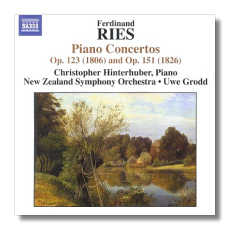
The Internet's Premier Classical Music Source
Related Links
- Latest Reviews
- More Reviews
-
By Composer
-
Collections
DVD & Blu-ray
Books
Concert Reviews
Articles/Interviews
Software
Audio
Search Amazon
Recommended Links
Site News
 CD Review
CD Review
Ferdinand Ries

Piano Concertos, Volume 1
- Piano Concerto in C Major, Op. 123
- Piano Concerto in A Flat Major, Op. 151
Christopher Hinterhuber, piano
New Zealand Symphony Orchestra/Uwe Grodd
Naxos 8.557638 DDD 60:57
Ferdinand Ries (1784-1838) wrote eight piano concertos, and Naxos is endeavoring to record all of them. This is the first installment. Because the works are numbered not in their order of composition but in the order of their publication, Naxos has dispensed entirely with the numbering on this issue. (For what it's worth, the C-major concerto was the sixth to be published although it is an early work, dating from 1806. The A flat-major concerto, also known as "Gruss an den Rhein," comes from 1826.)
Ries was a pupil and friend of Beethoven, who apparently complained that Ries imitated him too much. Ries' symphonies – the ones that I have heard, anyway – definitely reveal him to be a chip off the old block, although not on the same level as his mentor, of course. Beethoven's influence can be heard in these concertos too, and also Hummel's, but what is more remarkable about these works is the way in which they either anticipate or echo Chopin's two youthful piano concertos. Ries was a fine pianist in an era of fine pianists, and it is likely that he wrote his concertos – at times poetic and mellow, and at other times brilliant and sparkling – to show off his not inconsequential talents at the keyboard. For the most part, these are sunny works. When melancholy's cloud passes over, it is quickly dispelled by skittish passagework or by a rustic or martial strain. This music is neither deep nor original, then, but it is extremely enjoyable.
Christopher Hinterhuber is a young Austrian pianist with a brilliant technique. The notes in his runs are as clean and even as pearls in a necklace, and he uses an appropriately light touch throughout. It must be tempting to turn the A flat-major concerto into "Son of the 'Emperor'," if you will, but he resists the temptation. One could imagine the lyrical passages being played with a little more warmth, but it is good that Hinterhuber erred on the side of making these concertos seem more Classical than Romantic. Uwe Grodd, who has conducted some excellent Dittersdorf CDs (among others) for this label, seems to be in his element here. (The orchestra plays a more important role than it does in the two Chopin concertos, but not as important as in the Beethoven piano concertos.) The New Zealand Symphony Orchestra attacks its introductions and ritornellos with relish. Naxos' engineering is excellent, as are the booklet notes. This is worth a listen.
Copyright © 2006, Raymond Tuttle




















